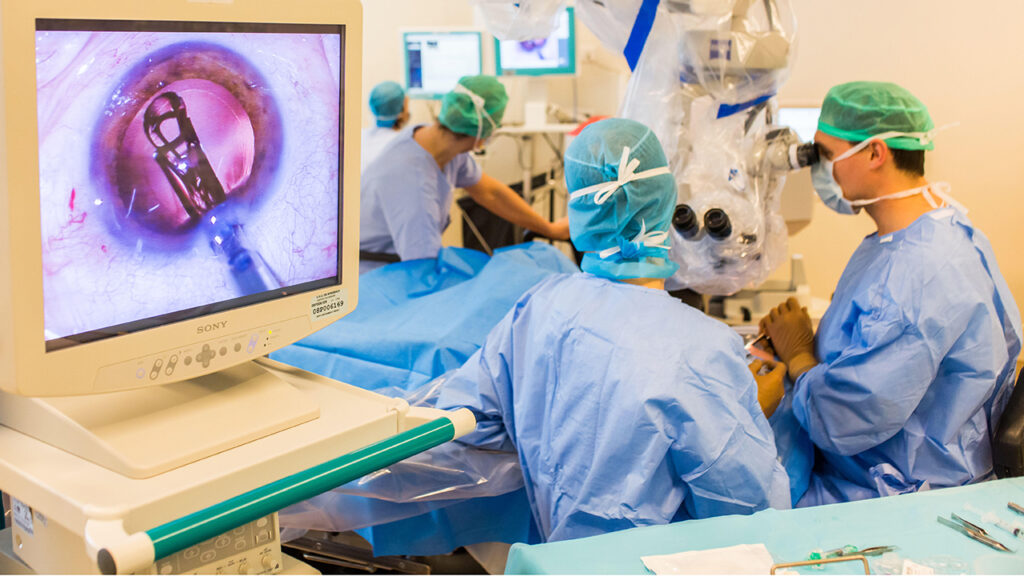Cataracts are a common eye condition that can cause blurry vision and make it difficult to see. But there are new treatments for cataracts that can help improve your vision. In this blog post, we’ll explore some of the new treatments for cataracts and how they can help improve your vision. We’ll also discuss some of the risks involved with these treatments. So if you’re considering treatment for cataracts, be sure to read this blog post first.
What Are Cataracts?

Cataracts are a common age-related eye condition that causes the lens of the eye to become cloudy and opaque. This can lead to blurry vision, difficulty seeing at night, and increased sensitivity to light.
Cataracts are caused by a build-up of protein in the lens of the eye. This protein makes the lens cloudy, which makes it difficult to see. Also, Cataracts are common in older adults, but they can also occur in younger people. Cataracts can be caused by genetics, diabetes, certain medications, and exposure to ultraviolet (UV) light.
Cataracts typically develop slowly and painlessly and usually affect both eyes. Symptoms of cataracts include:
- Blurry vision
- Colors appear faded
- Glare and halos around lights
- Poor night vision
- Double vision in one eye
If you experience any of these symptoms, make an appointment with an ophthalmologist to discuss whether you have cataracts and whether cataract surgery is right for you.
Traditional Treatments For Cataracts

There are several traditional treatments for cataracts, all of which aim to improve vision by removing the cloudy lens and replacing it with a clear one. The most common treatment is surgery, which involves making a small incision in the eye and then using a tiny instrument to break up the cloudy lens and suction it out. A new, clear lens is then inserted in its place.
Other traditional treatments include:
Injection Therapy
Injection therapy is a new treatment that involves injecting an enzyme into the eye that breaks down the proteins that cause cataracts. This treatment is still in the early stages of development, and more research needs to be done to determine its effectiveness.
Herbal Treatments
Several herbs have been traditionally used to treat cataracts. These herbs include ginkgo biloba, gotu kola, and bilberry. It is important to speak with a healthcare professional before taking any herbal supplements, as they can interact with other medications.
New Treatments for Cataracts

Cataracts are a common condition that affects millions of people. While cataracts can happen to anyone at any age, they are most common in older adults. Cataracts cause the lens of your eye to become cloudy, which can make it difficult to see clearly.
There are several different types of cataracts, and new treatments for cataracts are constantly being developed. If you have cataracts, your doctor will likely recommend surgery to remove them. However, there are other treatment options available, and new treatments for cataracts are being developed all the time.
Some of these new methods that are being developed to treat cataracts include:
1. Laser Surgery
Laser surgery has been used to treat cataracts for many years, but new techniques are constantly being developed that make this type of surgery more effective. One of the newest techniques is called femtosecond laser-assisted cataract surgery (FLACS). This type of surgery uses a femtosecond laser to create tiny incisions in the eye and then remove the cataract. This method is less invasive than traditional surgery, and it is just as effective.
2. New Intraocular Lenses
Intraocular lenses (IOLs) are used to replace the natural lens of your eye after cataract surgery. There are many different types of IOLs available, and new ones are constantly being developed. Some of the newer types of IOLs that are available include:
Multifocal IOLs: These IOLs allow you to see clearly at multiple distances.
Toric IOLs: These IOLs correct for astigmatism, which is a common condition that causes blurred vision.
Extended-depth-of-focus IOLs: These IOLs provide a greater range of clear vision than traditional IOLs.
3. New Medications
Several medications have been approved by the FDA to treat cataracts, and new ones are being developed all the time. Some of the newer medications that are available include:
Ocufilconazole: This medication is used to treat fungal infections of the eye, which can cause cataracts.
Brinzolamide/brimonidine: This combination medication is used to treat glaucoma, which can also cause cataracts.
Latanoprostene bunod: This medication is used to treat open-angle glaucoma, which can also cause cataracts.
4. Surgery Alternatives
While surgery is the most effective treatment for cataracts, some alternatives are being developed. One of these alternatives is called photodynamic therapy (PDT). PDT uses a light-activated medication to treat the cataract without surgery. This method is still being studied, but it shows promise as a potential treatment for cataracts.
5. New technologies
Many new technologies are being developed to treat cataracts. One of these technologies is called optical coherence tomography (OCT). OCT is a type of imaging that can be used to create a 3D image of the eye. This technology can be used to help surgeons plan for surgery and monitor the progress of the surgery.
OCT makes it easier to see the cataract and plan the surgery. It can also help surgeons avoid complications during surgery.
New treatments for cataracts are constantly being developed. If you have cataracts, talk to your doctor about the newest treatment options that are available.
Are New Treatments For Cataracts Effective?

Yes, new treatments for cataracts are effective. The most common type of treatment is surgery, which can be performed on an outpatient basis. During surgery, the doctor makes a small incision in the eye and removes the cloudy lens. In most cases, the doctor replaces the removed lens with an artificial one.
Other new treatments for cataracts include laser surgery and injectable drugs. Laser surgery uses a focused beam of light to break up the cloudy lens so that it can be removed more easily. Injectable drugs help dissolve the cloudy lens so that it can be removed with suction.
Both laser surgery and injectable drugs are effective at treating cataracts, but they may not be appropriate for all patients. Your doctor will determine which treatment is best for you based on your circumstances.
According to some reports, new treatments for cataracts have a success rate of over 95%.
If you have cataracts, you should talk to your doctor about your treatment options.
Conclusion
There are several new treatments for cataracts that show promise in clinical trials. Some of these involve using lasers to break up the cataract, while others involve injecting drugs into the eye to dissolve the cataract. The most promising new treatment is a procedure called femtosecond laser-assisted cataract surgery, which is safe and effective in clinical trials. If you are considering having surgery to treat your cataracts, talk to your doctor about all of your options and ask about the newest procedures available.
Cataract surgery is a safe and painless procedure. At EyeMantra we have a team of experienced eye surgeons, who will be happy to answer any questions on cataract surgery, cataract surgery cost, cataract lens cost for different cataract surgery types- Phacoemulsification, MICS & Femto Laser Cataract. Call us at +91-9711116605 or email at [email protected] for inquiries.


